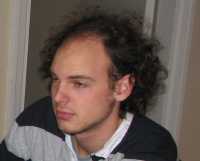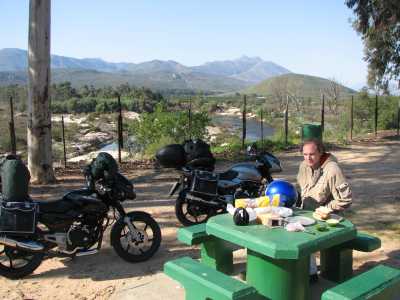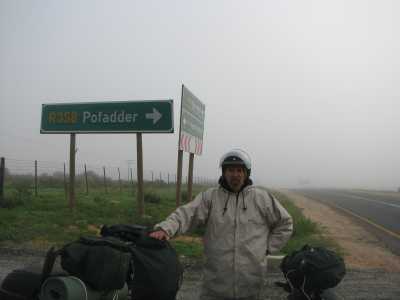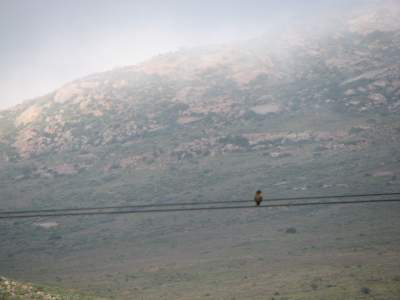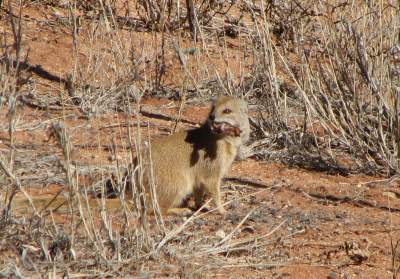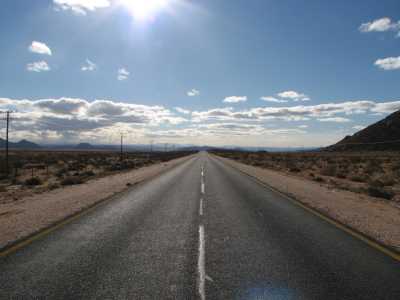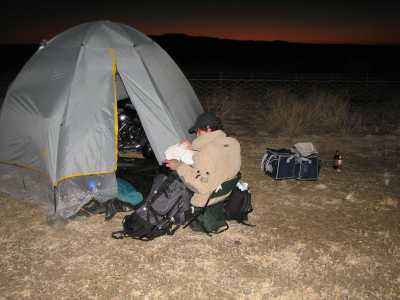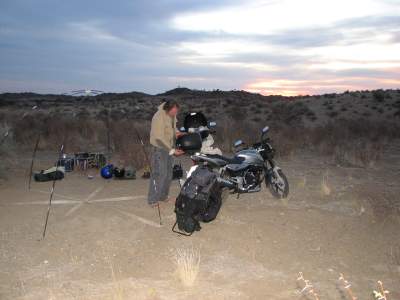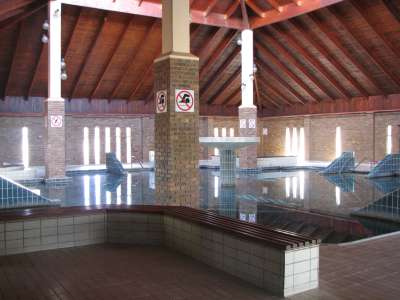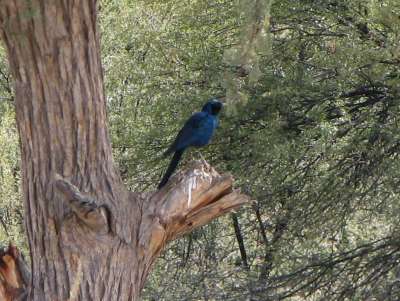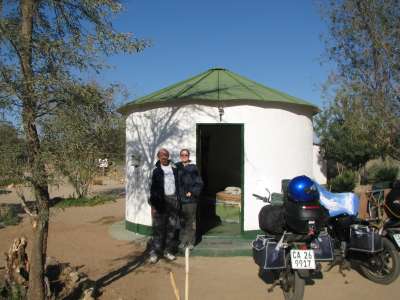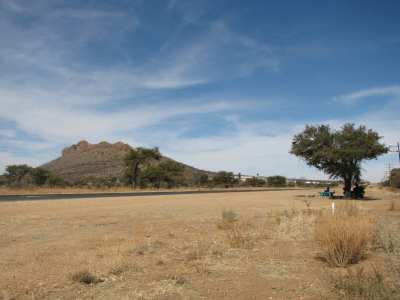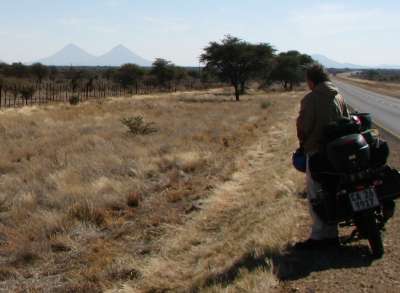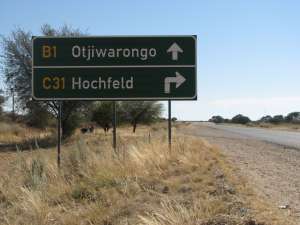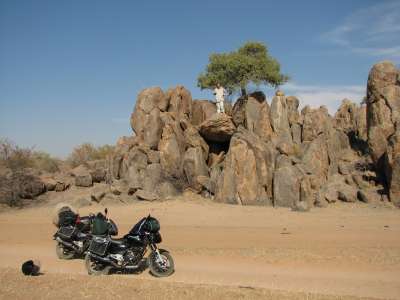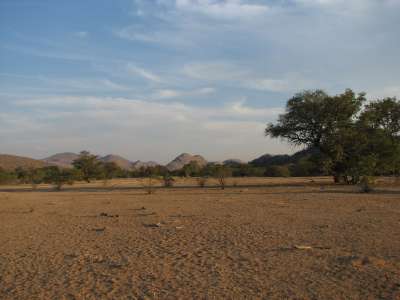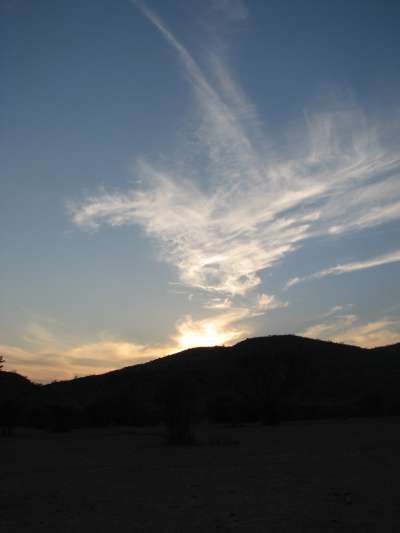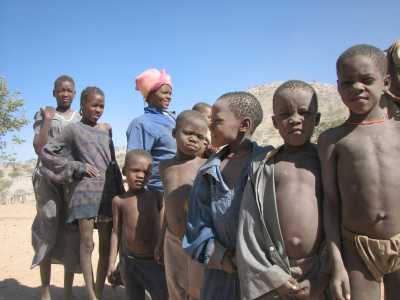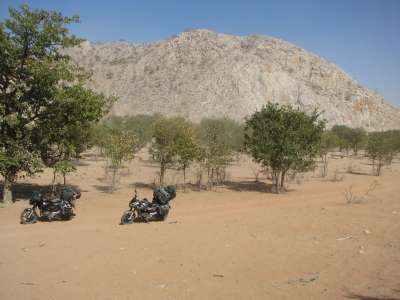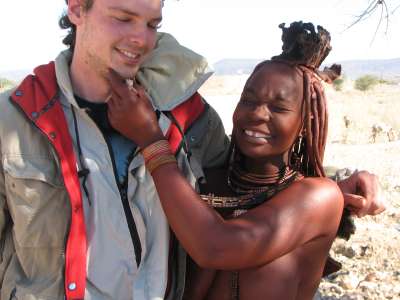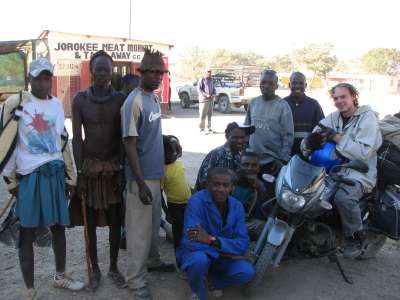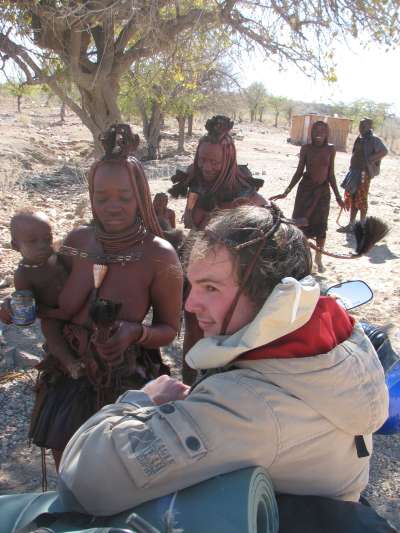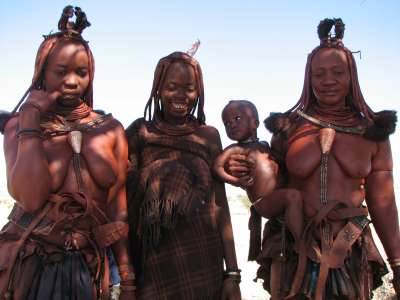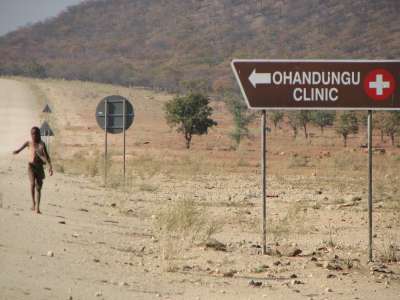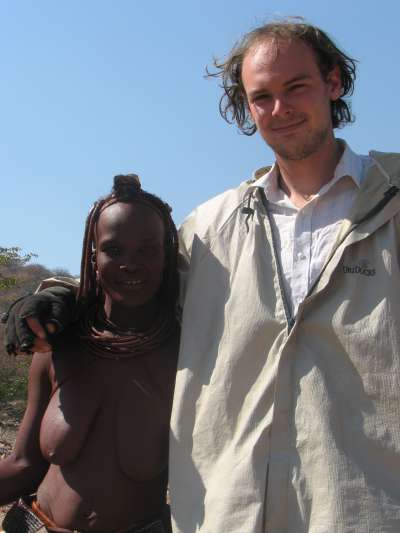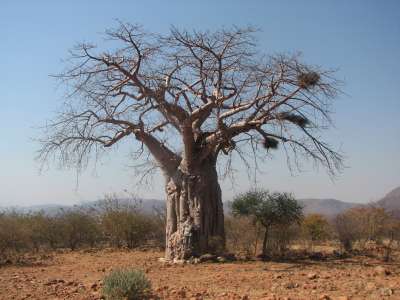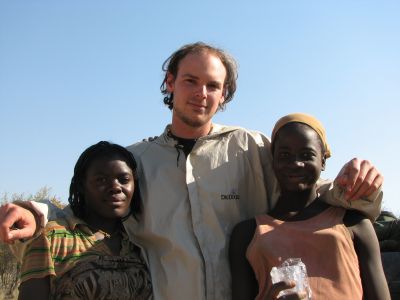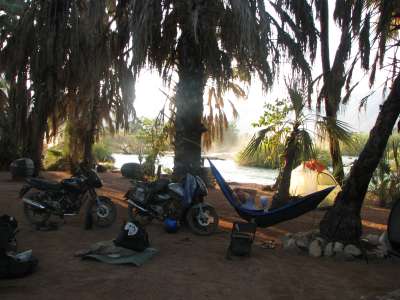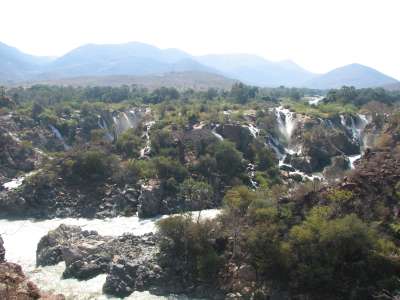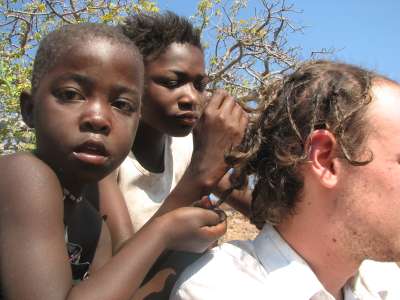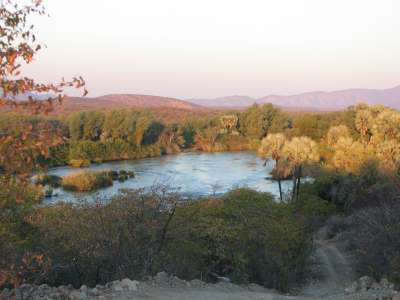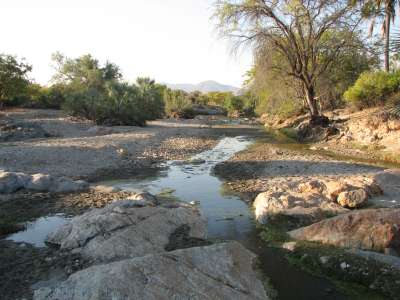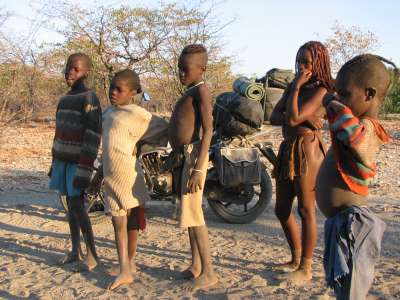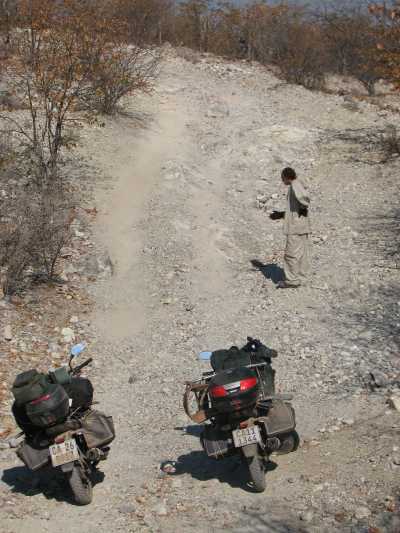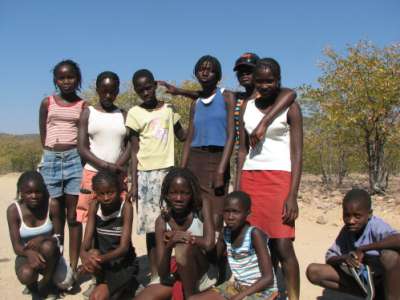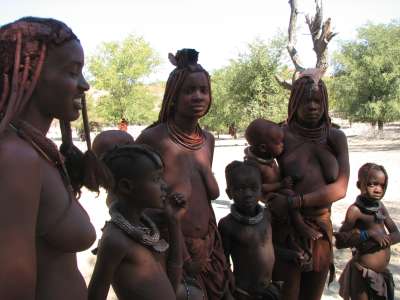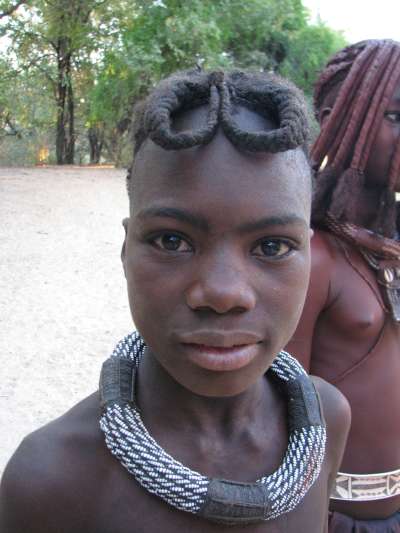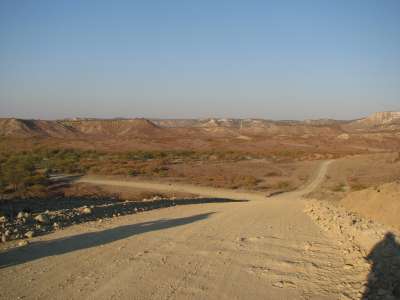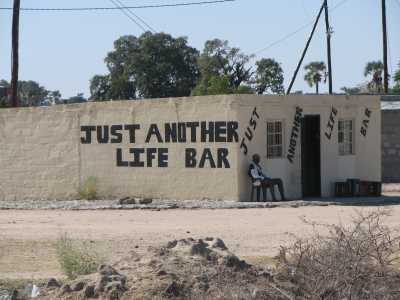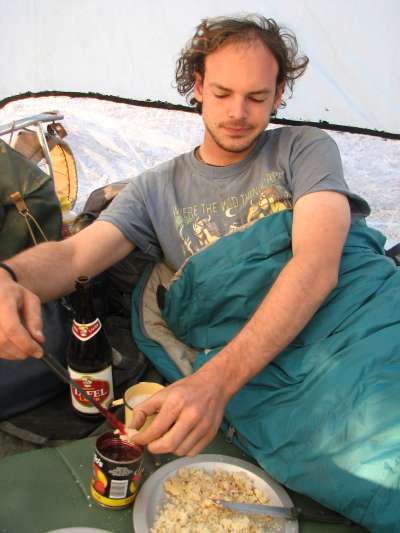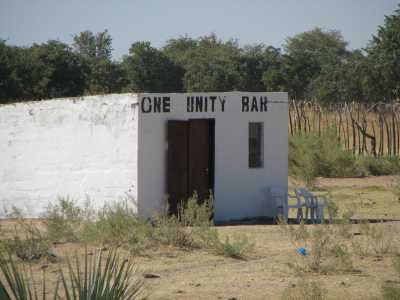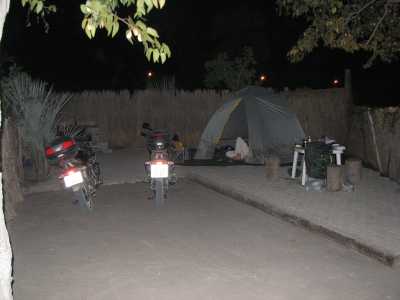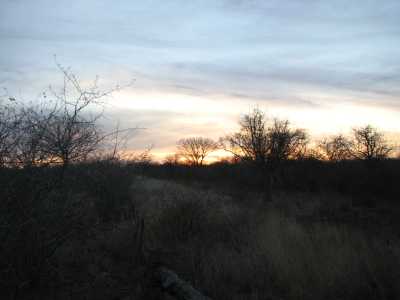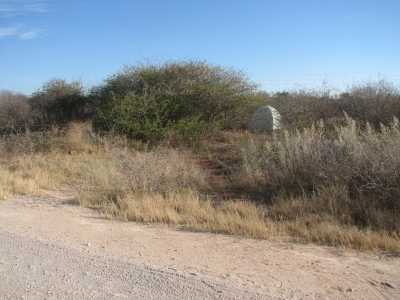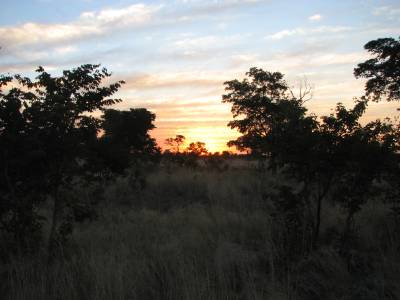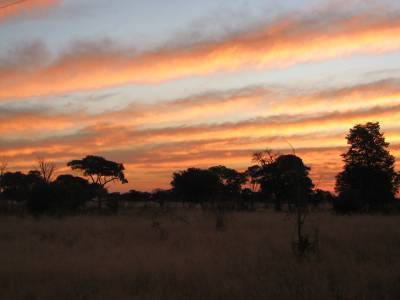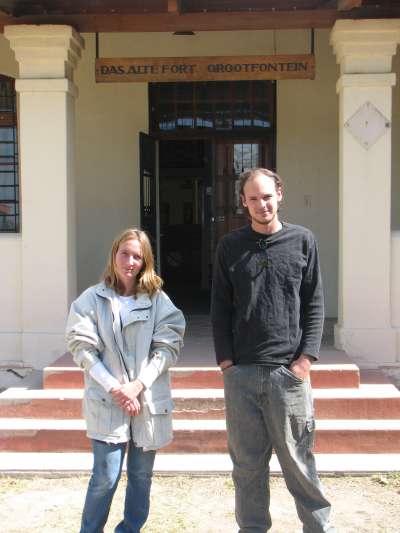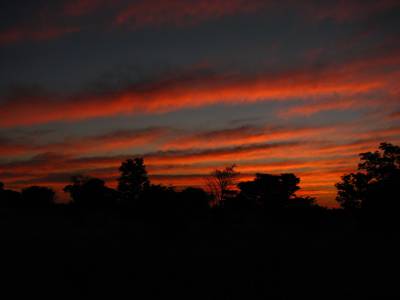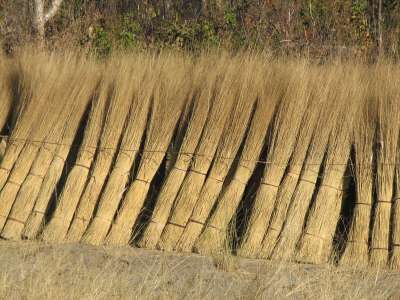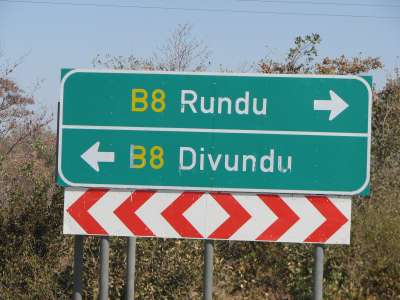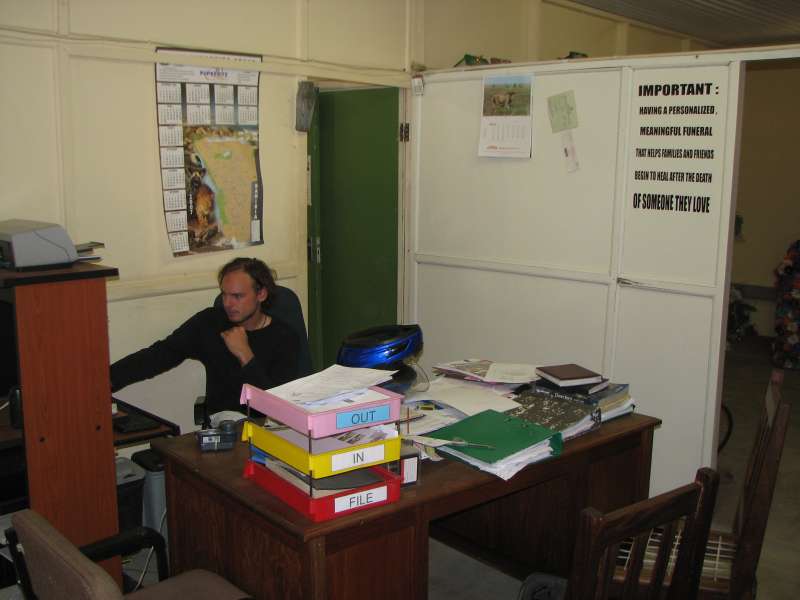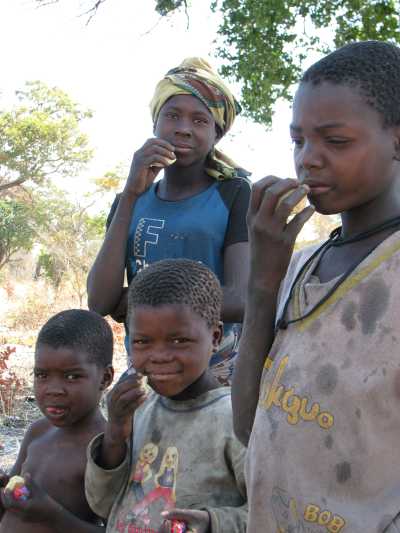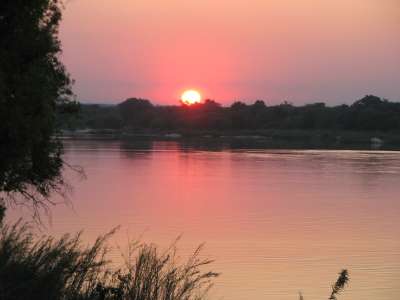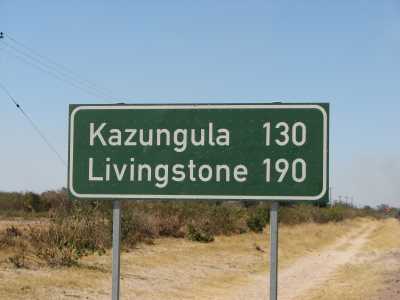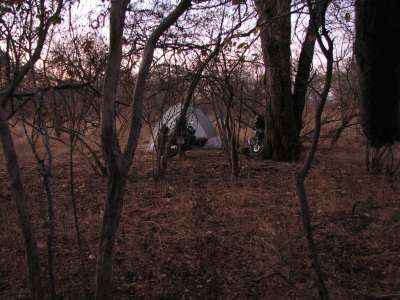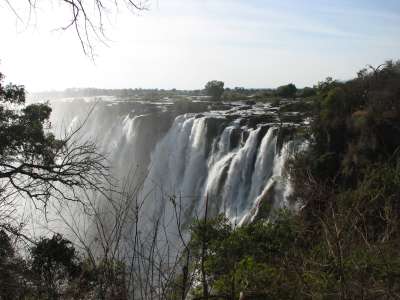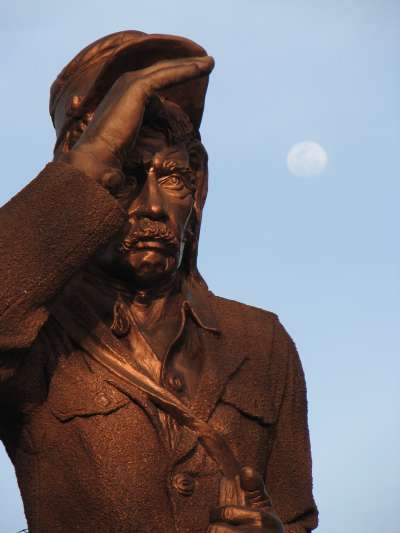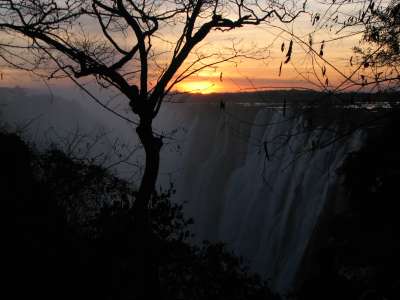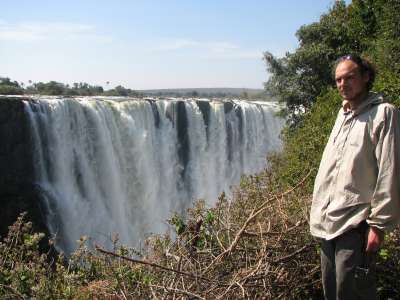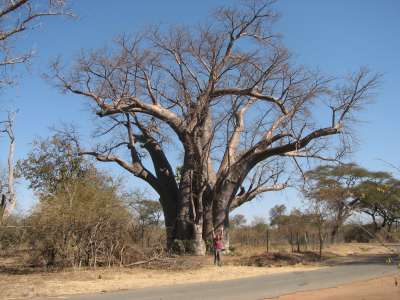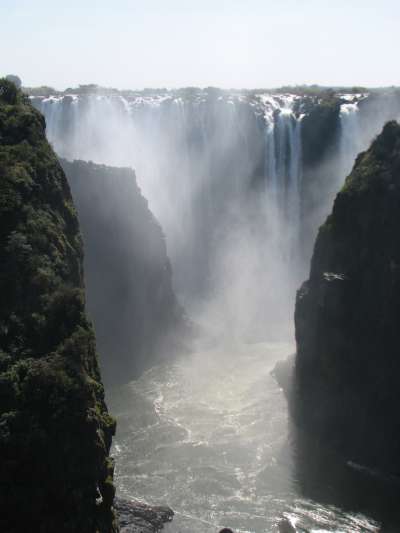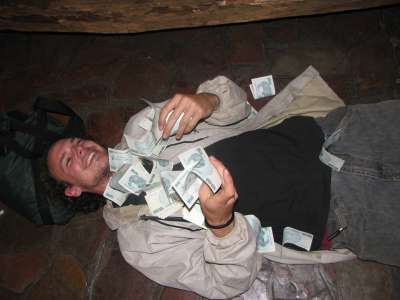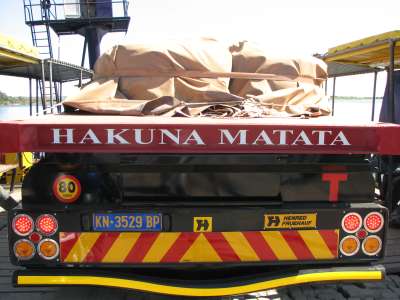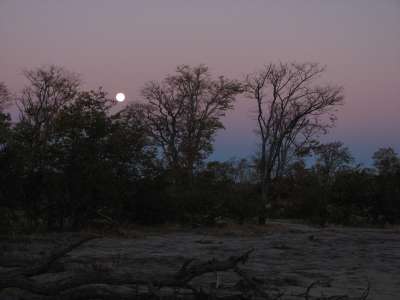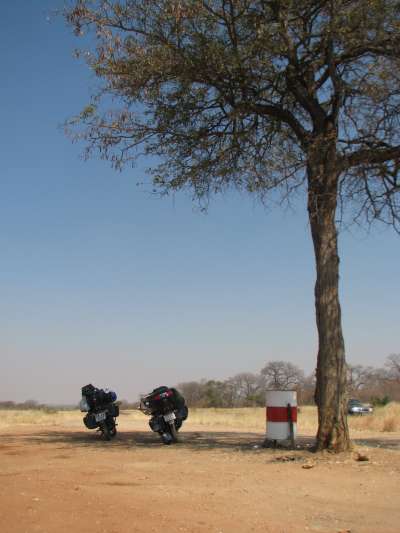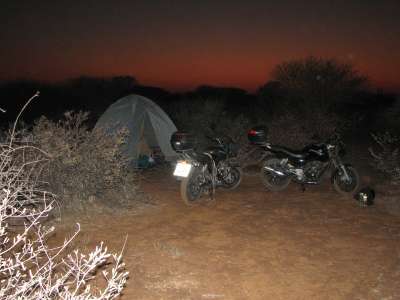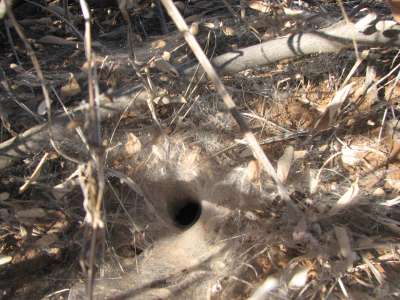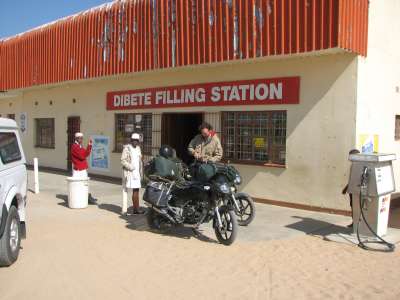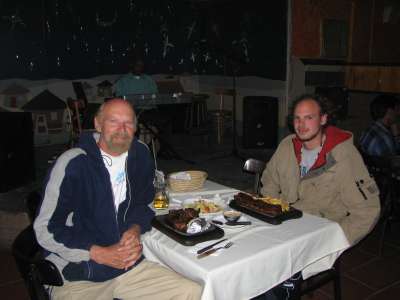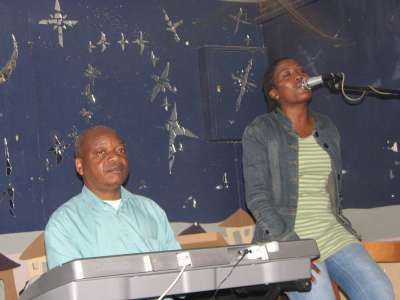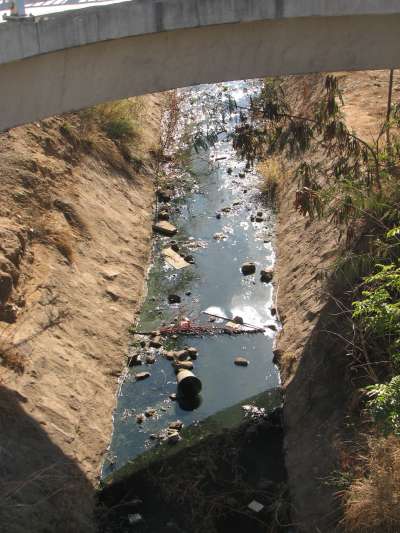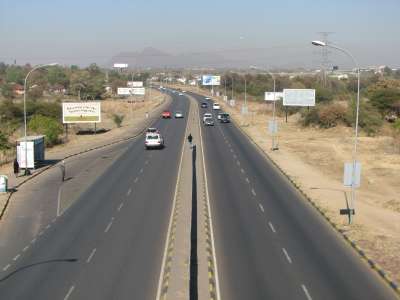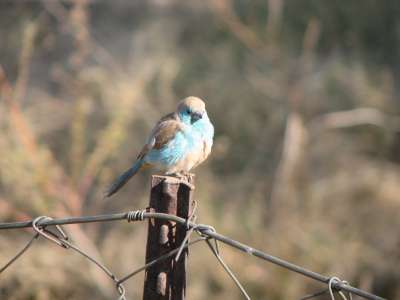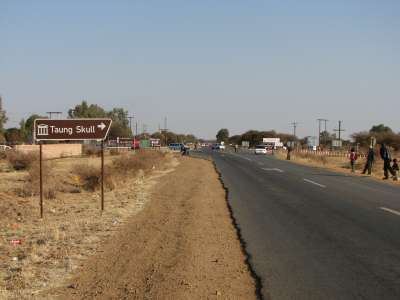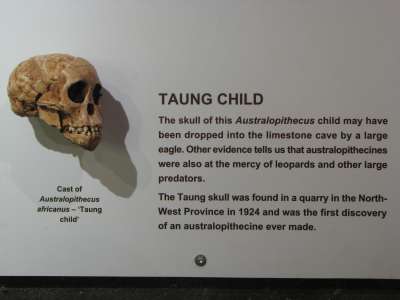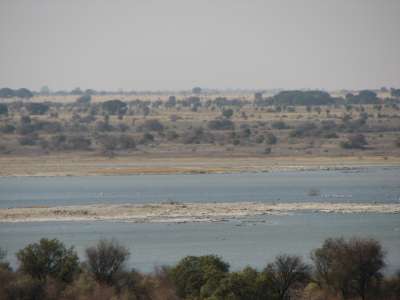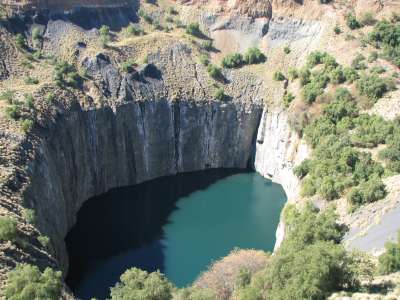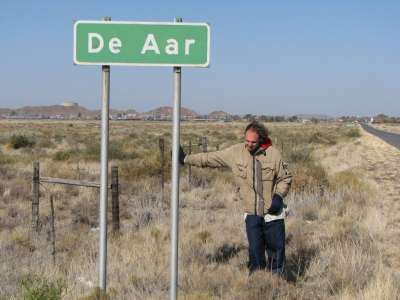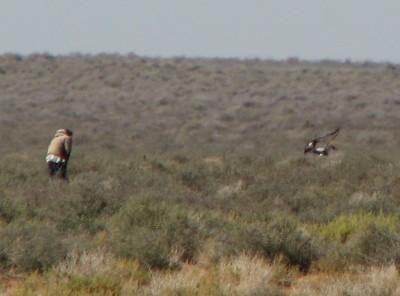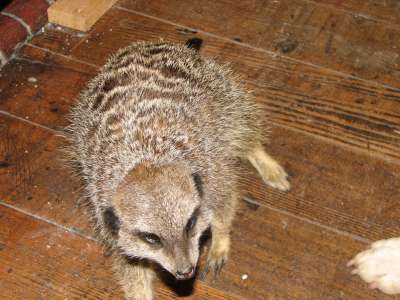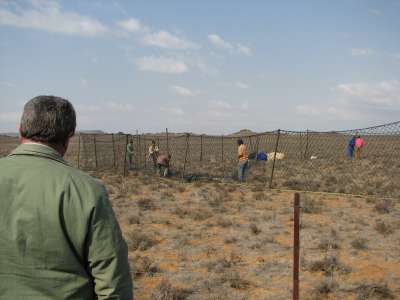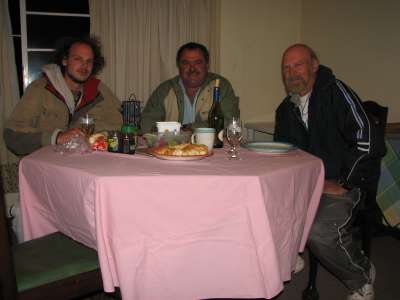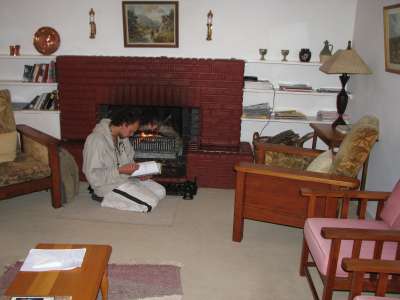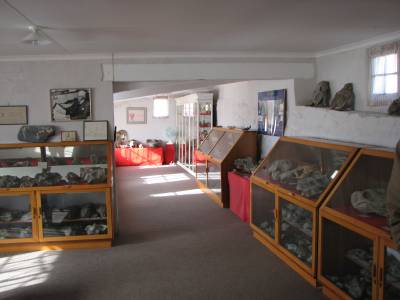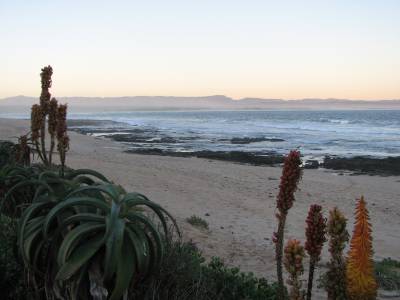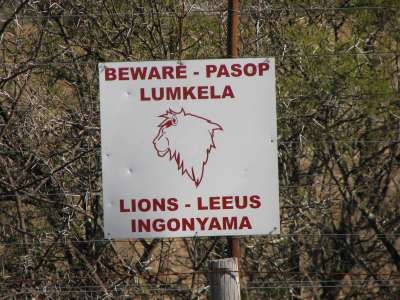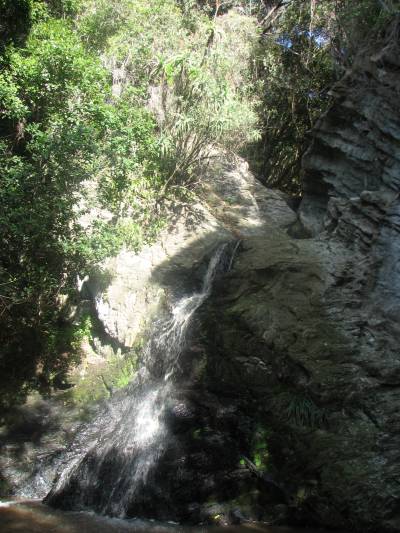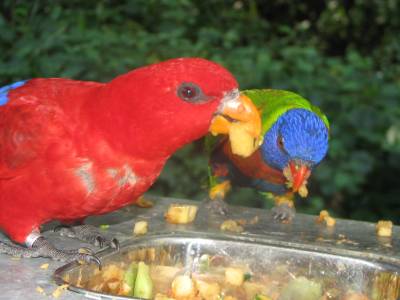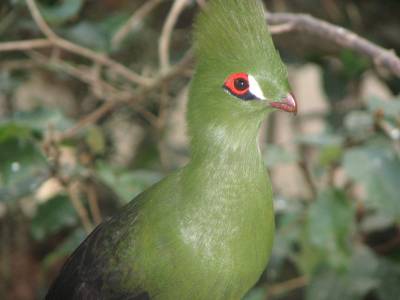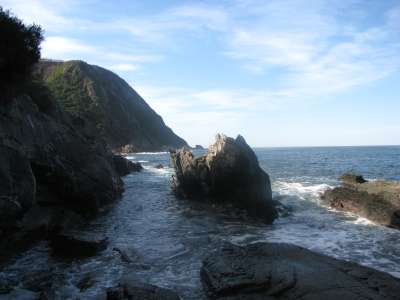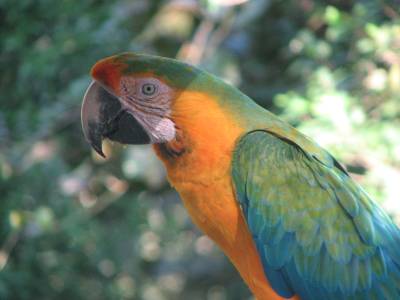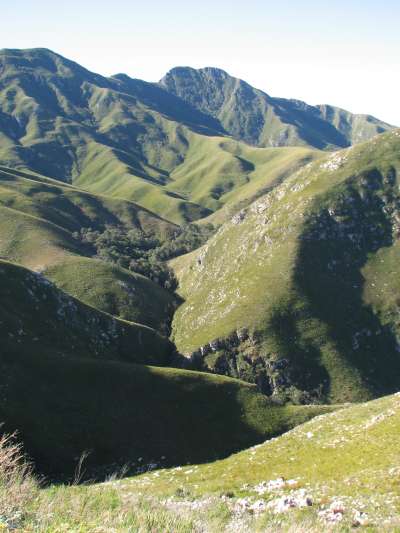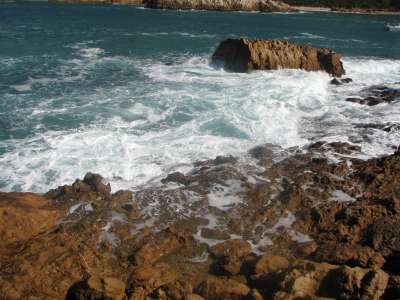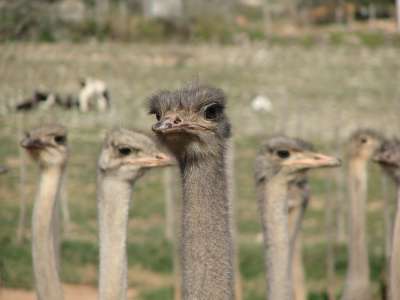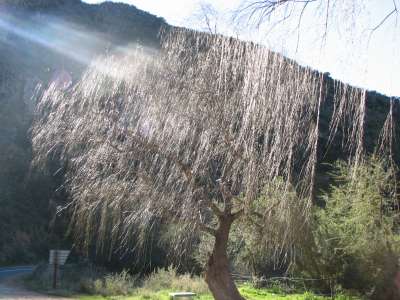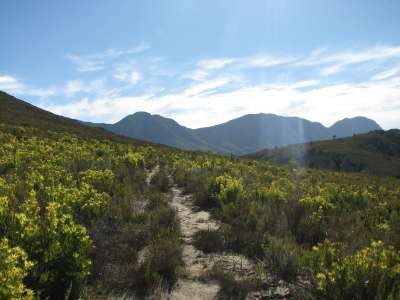Danjo goes Outjo |
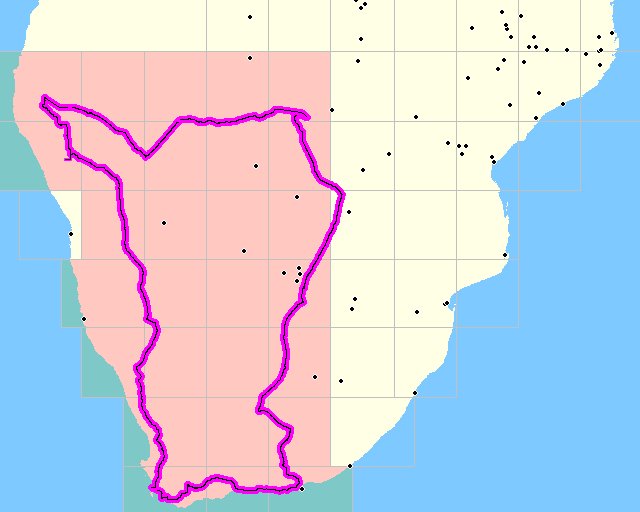
|
| Introduction |
Three years ago, I was visiting my father’s house in California, having a drink with the neighbours. Frank, smoking his cigar, had it in his mind to go to “The Falls”. He brought it up so often that it became a theme. Frank is Cuban, and he had only a general idea of the location, thinking Victoria Falls was the same place as Lake Victoria, somewhere in Africa. We all agreed to make the mission. We’d motorbike to the Falls. I returned to Cape Town after a year of traveling to save up for the trip. Unfortunately Frank couldn’t go because of work. After one aborted 2006 attempt, my dad, Charles, bought his non-refundable ticket to Cape Town, and arrived back in SA for the first time in 20 years. I looked into new and used bikes and decided on two 2007 Bajaj Pulsar Dts-I’s, the only new on-road bikes with a kickstart other than the Jialing RD200 delivery bike. We didn’t need a kickstart in the end, but you never know in desert terrain. The reviews claimed incredible fuel consumption. It was the cheapest and safest option.
|
||||||||
| Day 1 |
We left June 3rd, and after half an hour on the N7, I was already singing ‘Turn the Page’ with all of Metallica’s improvements over the Bob Seger version… “when you’re riding 16 hours, nothing much to saaaayyeeah!” We camped in Rust, at a truck stop.
|
||||||||
| Day 2 |
We passed through the Western Cape quickly. The Middleberg mountains, though insignificant, are the first eye-catching sites. Oranges squished on the road made Citrusdal a pleasant smelling petrol stop. From Klawer to the Van Rhynsdorp mountains were the best vistas before entering Namaqualand. I thought everything got beautiful just after the region’s welcome sign. In Namaqualand, we stopped in Garies, which has an interesting sheared hill across the highway. It seemed that everywhere we stopped from that point on was an outpost of inebriation, and the street folk emanated a palpable impression of imprisonment. In Springbok, some people called me ‘mylani’, and asked for food, and money to help get to Cape Town. I decided I didn’t want them in Cape Town, and gave them some bread to live one more day in Springbok. Starting sometime around now, I would lose cellphone reception for a month. We camped on the turnoff to Pofadder, after a tussle with the lady who thought she owned the land.
|
||||||||
| Day 3 |
In the Northern Cape, we were averaging about 90 km/h, which pushes the Bajaj revcount to about 7200 r/min. 8000 r/min corresponds to 100 km/h. It can go up to around 115 km/h before it starts getting into the red at 9000 r/min. We weighed each bike down to ~110 kg, and by our calculations, we got 3l/100km on tarred road, short of the ideal max, 2.4l/100km. The digital fuel gauge stays full for a long time past fullness, but once it starts to drop, it is generally accurate. After the scenic Vioolsdrif border post, like a valley through a miniature table mountain, we entered an entirely different landscape. My dad was upset by the practice of passing cars using his lane, potentially running the bike into the yellow line or off the road if wind is bad. It was a mostly South African phenomenon. Namibian drivers were generally more courteous. That night, camping on the side of a rare gravel turnoff, we saw an incredible new moon sky, perhaps the most stars I have ever seen.
|
||||||||
| Day 4 |
It literally froze at night, and was frigid all day, completely unexpected for a desert. Southern Namibia is desolate, and the first big town, Keetmanshoop, is slightly troubling. Three children fought over who would watch our bikes, which were parked directly in front of the grocery store entrance. Being the only criminal elements in sight, I told them not to watch the bikes. We camped on a turnoff gravel turnoff, behind some bushes. Natives on a carriage went by at night, yelling at the horses.
|
||||||||
| Day 5 |
We stopped in Rehoboth Spa, the only visitors in a resort-like grounds, fenced from the shacks. It was brilliant value (though I can’t imagine the locals get my spa $$). You can imagine the Bastervolk in their northward trek, being as pleasantly surprised as yourself to leave the arid shrub and enter fertile hilly land with large trees and hot springs.
|
||||||||
| Day 6 |
On the way to Windhoek, we chased an ostrich down the road, Indiana Jones boulder style, wondering why it doesn’t just get off the road. At a rest stop 30 k’s before arriving, some guys pulled over and said there was a baboon in the rubbish bin, and sure enough, it was startled awake, and climbed out, stumbling away. It was very nice north of Windhoek, with baboons and warthogs on the sides of the road. A vortex of clouds made an awesome sunset. We slept in Okahandja at the King’s Highway restcamp, in a bungalow instead of a tent.
|
||||||||
| Day 7 |
Outjo was the first place where Himba women sat around in town. We stopped at a German backerei to buy some fruchtkuchen. We passed through Otjiwarongo, the nicest town yet, and filled up one last time in Kamanjab, which is little more than a petrol station. The road, “C35” north at Kamanjab began as a gravel construction detour of about 30 kms. They were making substantial progress on the tarmac road, and there was varied hill scenery, [with one mountain on the left looking distinctly like a seacow].As usual, we found a dirt road, this time “D2666” and set up the tent behind some shrubbery. There was a soccer stadium nearby. |
||||||||
| Day 8 |
The plan was then to turn to the unknown and take the road called “C40” to Sesfontein. The first problem was that there was no such road. But after turning around at Hobatere lodge, we deduced that the correct road is called “P3223”. The soft sand goes through a roadside village and into a maze of 4WD tracks. We fell over in the soft sand about 3 times each. The crashbars prevent damage to the bike itself, which is great, compared to my Honda Cb250 in Spain, whose fuel tank dented when it fell over in strong wind one night. We learned here that Bajaj tires are not designed for soft sand. Getting across 50m of beach sand requires removal of luggage, or straddled running along without sitting down. When the Bajaj falls, I can pick it up, but in some cases such as when one cannot get a good footing or grip, it can require two people. 15 kms in we went through a veterinary cordon gate, known in Namibia as a ‘red line’ and into a Nama village called ‘iArizona’, set in a dusty windy valley. We made another 10 kms before setting up camp. We did not bring nearly enough provisions, and were forced to turn back the next day. At night, frogs in trees and undergrounds laughed incessantly, presumably at us being 25 kms into the scrub desert with no water. It was really pretty, but 16 km/h was optimistic and we hardly left 1st and 2nd gear. Only for the brave and prepared.
|
||||||||
| Day 9 |
Back on the C35, we entered an area marked as “Construction next 100 kms” and managed about 45 km/h on the gravel detour road. We had to stop for a beer, and chatted with some teachers before Okatjiura’s turn off to Opuwo. They were proficient in English, and said watch out for skelms in Oshakati. We turned at D3709, and slept in between villages, 100m from the gravel road. Locals and a few animals could be heard occasionally.
|
||||||||
| Day 10 |
From a distance, Opuwo looked like it was on fire, but then we saw it was just a dust hurricane. [The guy at the petrol station reckoned a used bakkie was better value than 4 new Bajaj]. I was in a fould mood, because I was bugged by hawkers and shortchanged by the Opuwo supermarket. Thus I was not that impressed with Opuwo; even the half naked women who strut in the “street” of Opuwo did not cure my grumpiness. My dad thought it was great, amazing. “Come on, Opuwo is special”… It was just then, sipping my long awaited Fanta on the outskirts of town, ready to leave, when two Himba girls, about 16 and 25 came down from their huts, and we would stay an extra 2 hours, giving substantial amounts of money to their family in exchange for pictures and authentic Himba trinkets. I had an unintelligible connection with the older girl, Jueena, and I gave her my Costa Rican necklace, which Brian or Andy had brought me from their travels. She in turn gave me one of her bracelets, some sort of carburetor head gasket, which I wear indefinitely, since it won’t come off (and it looks pretty slick). I will miss her, and will wonder how my life could have been, living in a hut, looking for wood while the womenfolk bargained with tourists, selling their uninhibitedness to strangers, carrying babies on their sides, singing and clapping to funny dances upon my return. Charles tried to appease children with 2 magnets instead of money. One angry kid said ‘How can I buy bread with these?’ Imagine if John Clerk Maxwell was so insolent. I generally asked for the magnets back when they pulled that shit.
|
||||||||
| Day 11 |
Earlier yesterday, Charles spoke to a guy in Opuwo, asking about road conditions, and we were invited to stop in Okangwati later. So today we made it to Okangwati, on the graded gravel road, meeting various Himba along the way. One couple, (a guy who looked like Seal, and a pretty girl on a donkey), wanted clothes. They were sly, and I ended up giving them 2/3 of our only towel. They were actually quite annoying, ungratefully asking for so much and being so useless. We stopped by some clinic, and I showed kids what all the motorcycle buttons did. They liked the horn, and said ‘see you’ when we drove away. We stopped for an hour to lend some people a bicycle pump to pump up their car tyres. A cattle herding girl was very smily, and taught me “Touweeeee” is the Himba version of Herero’s three ‘Wa penduka’, ‘Wa uhara’ and ‘Wa tokerua’ for greetings. Near the end, we were chased by some screaming girls after I did some movie star gesture. We had nothing to give them, but they posed for various pictures. At the end, I gave them the picnic set in my chair, and let them have my spatula, which we hadn’t used yet. We tanked up in Okangwati, also buying some canned food and beers. We found the place, and Heinz gave us some beers and showed us his motorcycle pics. He was very helpful, giving us 10l of petrol, as there would be no more until Ruacana. So with our full tanks and 10l extra, we set off to Epupa falls, camping not 5km from Okangwati. There were people close by, and we could hear their conversation as they passed on the road. At night, going on and off every half hour was some jungle house music, probably from a car’s sound system. I had visions of Himba women drinking and dancing. Just 50 kms from Epupa Falls.
|
||||||||
| Day 12 & 13 |
Epupa rocks. First time to put up the hammock, at a nice campsite adjacent to the falls. Epupa meaning ‘falling water’, is an oasis paradise after all the desert-like terrain. The palm trees are a nice touch, and populate the entire length of the Cunene river. White folks have dominated the Falls, and the locals only use it for washing and filling water buckets. Apparently Himba women don’t bathe. They just smear their red ferrous dirt on their skin with butter. They don’t smell bad. Quite nice, actually. The camp was superb value, at R50/person.night. Bloody worth it. Can’t see how the other camp can charge 20x as much. We stayed 2 nights and met our neighbours, Neville and Cathy, a RSA Navy diver captain and wife who had traveled 58k km in their Bedford truck. It was a behemoth. They made us tea and cookies and gave us some roast lamb. The Kenyan Brits in the other site spent most of the day nursing Glen, who had heat stroke. Glen, Janet and Veronica chatted away.
|
||||||||
| Day 14 |
A car alarm went off for 10 minutes while the Germans scurried off. We left without paying, like Robin Hood. We began the road to Ruacana, finding the path through town after an incorrect trail along the river. Charles asked a local man with a walking stick, “Ruacana?” pointing, doing all the gestures one could use, while trying to express being lost. The man started walking in one direction, and Charles just drove up to where I was waiting. Was he going to walk the 100kms to Ruacana in front of us? We followed an intrepid bastard’s bicycle tracks for 15 kms, and traversed a 100m dried river bed, stopping a few times to rest the bikes, as they were sounding stressed. I just run along standing above the bike, but Charles takes everything off his bike. Either way, it requires a stop after the initial running start is used up. We saw lots of vervet monkeys. We stopped by one Himba village, and I didn’t say anything, until the end, ‘Wa uhara’, and the girl found my surprising greeting hilarious, as I had appeared to have nothing to say because of language barriers. Leaving that village, I looked to my left and saw in the bushes a Himba woman, quite beautiful, with her legs spread eagle, staring ahead at my peripheral ‘Woah hello’. We passed our first 4WD convoy of 5 cars at a particularly nice riverside stop. The English SA bloke gave us some pork for the night to have on a fire. There were surprisingly few mosquitoes, and our malaria tablets were wasted. I only got bit once, and survived.
|
||||||||
| Day 15 |
The next day, some Himba children ran after us a whole 2 km or so, back to their village. The ones who could keep up were rewarded with Chappies. They were fast little buggers, but if it’s any indication of the speed we were going, the kids kept up with us. We averaged 36 km’s a day, and that second day I refer to as judgment day. I finally cracked and said ‘I am not happy’. Day 15. It was hellish terrain, and you couldn’t stop and enjoy because of the goddamn flies. I was their lord and island. I had an ineradicable fanta craving. The crash bars, which I praised, were renamed ‘shin breakers’, as the copious amount of falling over suffered that day was mostly only felt in our shins smacking the bars. We charged some hills that would delight motocross enthusiasts. There was one hill we went down that was even worse than the way up, and Charles thought it couldn’t be climbed, but don’t let it stop you from trying the route ‘backwards’ from Ruacana to Epupa. It just looked bad because some 4x4s were going up it, and barely made it. You just need to prepare your plan of attack and charge it. Bikes are more flexible than 4WDs – they just require more concentration. I had to smoke that night, and I could sense the vanishing of tension, at the price of a slightly higher level of awareness. The extra second of calm, which brings you to the present, also knocks you out of the rhythm of normal winding down, cutting the connection of causality between a long day and the accomplishment of eventual rest. Instead you just don’t feel like you had a long day anymore.
|
||||||||
| Day 16 |
We set up camp at the top of a hill as the sun was going down. It was on a separate road leading south, and around the time the rice was done, we heard some natives walking along the main road. I thought I might have been tripping, but Charles confirmed that it sounded like one person, walking in place, chanting unreal oogabooga sounds. The next morning we descended the last significant hill, and had a relatively easy cruise along the river and through Swartbooisdrif. Trying out my pharmacological skills on the unwitting, I gave Strepsils, Pulmison and Theophylline to a guy named Vageleto, who had a sore throat. It was fun playing doctor. We bought a beer each at Swartbooisdrif, and beers for the interesting folks among them. We stopped at a cuca shop surrounded by a Himba tribe. It was quite a ridiculous minute that followed, as 5 BMW650 offroaders tricked out in full gear came from the opposite direction. One of them bumped into me without even a nod, either as an act of passive aggressiveness, or as a sign of incompetence. We went into the cuca shop, and bought some wheat beer, which tasted quite nice. The chief said I must sleep with his wife. I did some strange little dance with one of the wives, and they asked for clothes and smokes. I had no extra clothes, but I did a gesture to say I had some wacky tobaccy, and before I left, I handed the one wife a folded paper with the rest of my weed. She opened it, and realizing the contents, made an ‘ooooh’ sound, closing it to the onlookers, and hoarding it away as the voices grew. We went past some happy English & Herero speaking school kids, giving them all chappies. I forgot my one glove there, and for the next 1000 km’s I looked like Michael Jackson with my one fingerless glove. We stopped by the very last Himba village before leaving Himbaland. Here was the first Japanese tourist yet, and lots of baby goats. Soon the school kids caught up. These Himba living on the outskirts of their land were used to tourists, but were still a bit puzzled that we took more pictures of the teenagers than them. I told the girls the chappies must be gross by then. No more flavour - spit them out. But they took offense to my logic. From the Kunene River lodge, we rode on nice graded dirt to Ruacana. We came over a hill, and raced down the gravel to the Ruacana hydroelectric plant. Charles was in front of me, and suddenly slowed down from 60 to 5 km/h to go over a slope. I was in rare Xtreme form, and couldn’t brake in time, falling over at about 10 km/h, scraping my arm pretty ugly. Nothing major though. The bike’s brake pedal bent around, but still functioned, and there were cosmetic scratches to the front right indicator. We slept above the Ruacana Falls road, and despite my injuries, I was quite happy.
|
||||||||
| Day 17 |
The next day we drove all the way to Ondangwa. In Ovamboland now, a long agricultural aqueduct runs along the right side of the road. After all that up and down on cobble stones, we decided it was a good time to tighten the chain. [Loosen left, loosen right inner, tighten nuts on both sides with equal twists until 1 inch of slack, tighten right inner, tighten left]. The Bajaj toolkit is missing the 8mm wrench to open the air filter. The kraals become more and more frequent, reaching high density as you get close to Oshakati. The stretch to Ondangwa is so populated that it’s hardly a different city. I was told there is anti-white sentiment there from all the mines and war deaths that white man has brought to that area. And it manifested for me as the till lady, who took about 5 minutes to check and bag 5 items, while all the other lines went by at normal pace. The guy in front of me started yelling at her to hurry up. At my turn, she didn’t look up or reply to my ‘wa lalapo’. What does one racist cashier matter to me? I was amused. I bought some sunglasses in the parking lot, and wearing them, tried explaining to another guy that I already had sunglasses, and didn’t want a wallet. We looked for the Ondangwa Oasis rest camp, and found it one road behind the Shell. We ate pilchards, rice and papaya. I drank a few pints at the bar and listened to Afrikaans liedjies, and Charles gave the money we withheld from Epupa Falls camp as a tip to the malaria infected bartendress. There was African dance music next door, and Ondangwa sounded like a pretty happening place. A girl came by asking for money, I gave her N$5, and she had a tear, saying “it’s that I’ve lost my kitty, you see”, which was bullshit, but funny. There were lots of bats in Ondangwa.
|
||||||||
| Day 18 |
The owner let us use his son’s internet, which I thought was necessary incase Hotmail still had its 30 day account disabling policy. [I also wanted to ask why my apartment deposit had not been returned yet.] He is one of the four IT guys in northern Namibia. So that was lucky. I found out that because of a misunderstanding I didn’t get some job. I wrote to the other headhunter to tell her to look for a job for me. We drove to Tsumeb, the copper capital, and filled up. Everything was going well until a robot turned red. For almost 1000 km’s I hadn’t thought much of it, but then the little carved coconut trinket I bought in Kamanjab and had hung in the throttle-groove got stuck. I didn’t understand why the bike wouldn’t stop and only wobbled when I braked, and I drove into Charles’ sidebag in front of me. I fell over again. This fall bent the crash bar a little bit as well as the left handle. It also hurt a lot more than the first fall, probably because of the tar road grinding my skin and the bike landing on top of me. It took us almost an hour to attach the now strapless sidebag and putter out of town to set up camp on a sideroad. We found a nice spot surrounded by thorn bushes and barbwire fences. I beat the plants mercilessly with a metal stick. My arm looked radical with its multiple wounds.
|
||||||||
| Day 19 |
We took the next day easy, spending most of the day at the Grootfontein museum. We remarked how calm and peaceful the town was, how green and suburban. A strange peaceful conformity made it seem the opposite of Oshakati’s anarchy. We went to ‘Der Alte Fort’ museum for a good few hours, looking at the huge old steam engines and funny inventions for decorning cobs and unprickling pears, and so on. We chatted with the friendly curator, Helen, who had stories about her pet boomslang and her husband’s crocodile catching days and her stolen dog and lions eating robbers, and to watch out for cows in the road. We slept somewhere far from the road.
|
||||||||
| Day 20 |
We rode into Rundu past all the orange gourd and thatch bundle sellers, past a township area, into what seemed to be quite a large town. I checked my email again at Sparks Enterprises, an entrepreneuring internet café and funeral home. We bought 3 orange gourds from 3 kids. It cost N$3.50, and we gave them a N$5 telling them to keep it, and they didn’t want it. So we gave them the exact amount. We looked for a place called Bagani, but it was called ‘Divundu’, and we stopped 10 km’s before. It was difficult finding a place away from the kraals, but we saw a nice spot after a community forest. A police car and 5 army vehicles drove by as I pretended to take a slash on the side of the road. We set up the tent in a cow field behind the trees, with little yellow tomatoes and sticky burrs. An animal grazed outside the tent.
|
||||||||
| Day 21 |
In Divundu, we bought ZigZags, a bag of cardboard tasting cookies. We entered the Caprivi Strip. Trained kids asked for dollars.
We saw an elephant and stopped our engines to take photos. Charles’ camera ran out of batteries, and the elephant started walking towards us. We simultaneously turned on the Bajaj engines, and the olifant got a big scare, turning sideways. I was to look right, and Charles left, that way we’d see some animals. But I don’t think we saw any more. People were burning the roadside grass, and it was the dry season, so all the animals must have been at the waterholes. We camped at the Zambezi River lodge in Katima Mulilo. The sunset was great, and I kept saying to myself, ‘The Mighty Zambezi’ in a James Earl Jones voice. On one side were 3 Afrikaaner couples from Pretoria in a 4x4 convoy, and on the other side was Thera, a UC Berkeley grad student, studying the Totella language. She had been in Zambia for about 3 years, on and off, and had a couple international conference papers to write on the grammatical differences between the northern and southern dialects. She was traveling by foot, and had lived in a village with a local family, inadvertently teaching English to a people who speak a dying language. Later a lone BMW1200 biker arrived and parked next to us. His emblem said ‘Bikers for Jesus’ or something, and he was handing out bibles across Southern Africa. It was his second day traveling, and he had been in 8 countries. He was setting some sort of record, but his thrust bearings had to be nursed back to Windhoek for a repair. He used to be a millionaire, but all he had left were his motorbikes, a grudge against his ex-wife, and 300000 km behind him.
|
||||||||
| Day 22 |
We went to the bridge, and crossed the Namibian border with no problems. On the Zambian border, we could have missed it completely, because it’s a caravan and a building without a sign, while the sign ‘Immigration’ actually just points to the other side of the river. We each paid R200 for 3rd party insurance, and R100 for carbon tax, and R45 for council tax. I got in free on my ZA passport, while Charles forked out US$100 for a 3 year multiple entry visa. So, R1400 later, we drove over the bridge to Sesheke. Sesheke was nothing special, but people were everywhere walking on and along the road for the next 10 kms. The road to Livingstone had about 6 or 7 potentially trip-ending potholes. The bush was a bit bushier and greener, and the numerous huts-in-progress told of a slow African lifestyle here. When we set up camp 20 kms before Livingstone, the traffic suddenly doubled. We set up the tent and then discovered a colony of giant ants had been awoken by our footsteps. They were huge, and their swarming on the grass made a hissing sound. Cows with bells grazed nearby.
|
||||||||
| Day 23 |
It was so cold the next morning that I was cursing the baby Jesus in a Scottish accent. Charles started wearing two pairs of pants and 5 layers of shirt. We got to Livingstone and were a bit lost. We went to Spar, got lots of food, and heard we should go to “the waterfront”. We got there around noon and went to the Zambian falls around 3pm. We were going to walk, but the security guard said an elephant on the corner had killed someone 2 days ago. It was improbable and too convenient that his next sentence was that for only 40000 kwacha, we could afford the shuttle to drive us the 4 kilometers. So we took our bikes, which was a good choice since we only left after the sunset. The falls were beautiful, and on the bridge you can see a 300 degree arc of rainbow as the mist soaks you. It’s a pity we didn’t stay for the lunar rainbow, but that’s quite expensive, and we had made it, which was the point. Let the lions maul me in Botswana. I have seen the falls. We had our “Mosi” beers and toast to Frank, then had a beer at the bar, where I wasn’t feeling very social, and we spoke briefly with a British girl named Kat who was traveling with an overland tour company. She saw Ewan McGregor on his motorcycle.
|
||||||||
| Day 24 |
We spent two days at the waterfront, so the second day we parked at the zim/zam border, traded US$60 for ZIM$4 million, which was a mistake, because we could have got ZIM$6 million on the other side. The guys convinced Charles that we needed a taxi to get to the falls on the other side. The border control was quick and painless, free for me, US$10 for Charles for the day. In the words of one Zimbabwean, “Zim dollars are valueless”. We could have gone in with US dollars, but it was novel to be a millionaire. Unfortunately my money has expired now, but I was a millionaire for 6 days. There were baboons that hung out at the border control. The Zimbabwean falls were not more impressive than the Zambian side. There were just more of the falls on the Zimbabwean side. The hawkers were very persistent, and would not stop until you bought something. We started telling everyone that we’d buy something on the way back. “Whats your name? Ok, So-and-so, I’ll see you on the way back”. We walked in a loop, to the big tree, and through the town of Victoria Falls. A kid asked for money, and I gave him a $10000 note, equivalent to 15 cents or something. We went to Wimpy’s, since we were millionaires, and bought cheese burgers at Z$295,000 each. You can get some seriously cheap deals on art there. After you say ‘No’ ten times, they start naming silly prices because they need to eat, or their kids need to eat. I gave my pants to a guy back on the Zambian side, because they got ripped in the Tsumeb accident. The guy who watched our bikes got 4000 kwacha, enough to buy one beer. He was happy with that.
|
||||||||
| Day 25 |
We went to the Kazungula ferry crossing, and saw about 30 trucks backed up, waiting to cross. We went ahead of all of them, and onto the next ferry. I got in free, and it cost Charles US$35 to get into Botswana. We heard later that a month ago, one of the 2 ferries tipped over causing a major wait, and these guys had to sleep on top of their trucks because lions started going there. At the border control on the Botswana side, there was an elephant munching on trees next to a big hole in the fence. We drove in some disinfectant and were on the road to Nata. About 100 kms from Nata, we stopped on a side road and set up camp near a microwave tower. There were elephant droppings and footprints everywhere, so we set up our tent by some trees, put the bikes on the sides, and didn’t see any elephants. Our fortress worked.
|
||||||||
| Day 26 |
Botswana only sells 93 Unleaded, and we had no more money, as there were no banks. We used our last R100 at Kazungula, and at Nata decided to go South, and forget the Okavango Delta this time. The guide books said there was nothing cheap about those swamps. 25km before Francistown, Charles ran out of petrol, so we poured the 2l emergency reserve in his tank. There were fences the whole time, but we saw an open gate, and parked on some farmer’s land. We figured if you’re rich enough to own roadside land next to Francistown, you probably don’t live in Francistown.
|
||||||||
| Day 27 |
It was damn cold again, and I needed to buy gloves. Charles needed a windbreaker. We found both at Pep. We spent a long time in Francistown, which is unique to the rest of the Botswana terrain we had seen, because of one or two little hills. This was also unique to me; because it’s the first city in Africa I’ve seen where all the inhabitants have a bit of pride. If you’re a white man and you wait on a corner in Cape Town or Windhoek for 2 minutes, you will be asked for change, or solicited. But in Francistown, you’re the only white guy, you don’t understand Setswana, and no one is going to say a word to you. We parked outside the town and a guy walked out of the bushes saying he was hungry. I made him a pb & j sandwich and gave him some water for his long walk. There was lots of traffic on the road to Gaborone. We made it to Mahalapye, which had a nice sunset, and then the road became 90 km of gravel detour alongside construction. There looked like nowhere to go, with fence on the left and construction on the right, so we took a chance and drove over the unfinished road in the direction of a worker camp, and followed a cow trail to a nice spot invisible from the road crews.
|
||||||||
| Day 28 |
We took our time packing up, and waved to the surprised workers as we continued to Gaborone. We stopped at the Dibete filling station, and some girl said there was no water. But then the other lady got some for us after we tried the bathroom tap to find it out of order. The girl pretended like she had never heard of Cape Town, but laughed. No, she has never been there, but she’ll find us. She had a walkman mp3 phone, which seemed anachronistic for a town with no water. In Gaborone, we got to some suburb and asked where we were. The guy there gave us a general idea, but he didn’t know where he was either. We found our way to the only camping site in the town, but Charles drove away, convinced it was another place. I followed him, hooting and flashing, and then watched as he drove away. He drove out of sight, and I didn’t want to be in Botswana alone, so I got back into traffic, kicked it up to 80, went through a red light, and only stopped when we were 2 kilometers away, in the wrong place. There was a rooster at the campsite who sounded just like the mental patient working in the library in Little Britain. Errr-AAAAHhhhh. We washed all our clothes, and went for our first restaurant supper of the trip, at the Bull & Bush. We tried the local light beer, St. Louis, and listened to a guy play Casio keyboard over midi files. I got the rack of ribs, and Charles got the T-bone steak. It was a huge meal. Afterwards, we stayed for an hour listening to the woman who was now singing with the musician. She did a good Whitney Houston and Lauren Hill. The lady outside got Charles to buy something. I wanted to go, because she was annoying. But some guy played Redemption song on his guitar, so I waited around while Charles bought another trinket for charity.
|
||||||||
| Day 29 |
The next morning we walked to the J&B Bookstore to the north. Gaborone also has a little mountain. There were little birds, and people selling furniture. The bookstore had a book on Satanism, in Afrikaans. I read a page, and it was hilarious. The book was dedicated to Jesus, and one chapter lashed out at heavy metal bands, naming bands that are hardly heavy metal. One page was about what to say so Jesus will protect you if the devil comes after you. ‘In die naam van die Vader, die Seun, en die Heilige Geus’. Imagine speaking to the devil in Afrikaans. He might say ‘Ag nee man, hoe kan jy my taal praat?’ I had to have it. We drove to Lobatse, and the Ramatlabama border crossing. School kids everywhere, and they wanted me to stop, and I didn’t, and one of them jumped and shrieked like a banshee, which I acknowledged as funny. The border control was quick and painless. We turned on a side road, and found a farmer’s open gate again. Hmm, I thought, do we really want to go towards a town called Tsetse, whose only sign is for their clinic? But it was a nice spot next to thorn bushes, ants and termites.
|
||||||||
| Day 30 |
In the morning someone walked past us. We drank our coffees and carried on to Mafikeng. Sweet sweet working ATMs. I had my flat deposit back, and we filled up. Everyone in the North West Province speaks Afrikaans. The road out of Mafikeng goes through residential area and then into a stretch of wheat fields and trees, with a sign saying ‘U is nou in die gebied van die wit leeu’. I kept my eyes out for the white lion in vain. We stopped at Vryburg, in the white neighbourhood Spar, and bought tons of food. Some guy said “Victoria falls on 180cc’s? I think the Scottish have the best word for that. ‘Darrft’ ”. Damn that fresh garlic bread was good with the grape fanta. Their one road was quite active. It was like Wynberg main road during a samoosa sale. We drove a lot, and turned off towards Ganspan to find a spot. It was technically the worst campsite yet, but I beat the ground into submission with my steel toes and metal stick. We passed Taung, where that one skull was found, and so we were in a paleontological mood.
|
||||||||
| Day 31 |
In the morning, the bikes were frosted, and it was damn cold. We stopped in Kimberley to see the Big Hole, or more amusingly in Afrikaans, die Groot Gat. It’s what they say it is. Good museum. Just opened 2006. They built that N12 road, I assume to run along the path of battles in the 1902 war. This was ant country now. Or maybe they were little termite mounds. We crossed the Oranje rivier, and I had an urge to see Orania, the last boer stronghold, but decided to continue towards Hopetown. We camped on the shortcut road to De Aar, towards Kraanskuil. We could hear some Hopetown music that night. Seemed like a happy township. Our paleontology was rewarded as we found a hole with a dog skeleton right next to our tent. I hoped the thing that ate it was not still around. But Charles pointed out that it was probably dead, and tossed in the hole. I performed satanic rituals with the skull.
|
||||||||
| Day 32 |
The bikes had frost again, and some people jumped out their bakkie and investigated us. They said in Afrikaans that they came in peace, and did we have food? We got back on the main road. Fuck gravel. Later I saw huge birds, which I thought might be pterodactyls. I chased them down, and Charles got a picture. They’re probably vultures, but in the picture, damn. I stopped in De Aar, to see where Lyndall and Marize come from. It was Sunday, and it was a ghost town. The only store open in the entire town was the Smith Brothers filling station. Not a single market open. Nothing. Wat is daar te doen in De Aar? The attendant didn’t know of the golf course with a bar in De Aar. So we moved on. We camped on the side of the road, a new low. It was in the middle of the Karoo, however, by Seekoeirivier, so it seemed like no one would bother us.
|
||||||||
| Day 33 |
It was too windy at night and we took down the tent to prevent it from blowing away. At 7am, an Afrikaaner in a bakkie pulled up next to us and asked if we were alright. We said, yep just fine, and he invited us to breakfast on his farm, whose secondary driveway we were sleeping on. He said come at 8am, so we got up in the freezing karoo morning, packed up with the fingers that still had feeling, and arrived 15 minutes fashionably late. After eggs and sausages and toast with G.P. and Linda, he asked if we were in a rush. So we stayed for the day to watch G.P. catch 20 springboks. He went to Hanover to pick up some workers. Because of new laws, he had to let go some of his old workers or they would gain land occupation rights. So he rounded up about 8 young bushmen looking fellows to help out. They put up a fishing net next to a fence. Then, with five guys on horses, one guy on an offroad 250cc bike, and the rest of us in the 4x4 bakkie, we started the chase. I was in the cab holding onto the metal bar as the vehicle raced over rocks and grass patches. The springbok were smart, and one bokkie ran ahead of the rest. When he saw it was a net, he ran back out, and the entire herd broke out of formation. Knowing of the net now, they couldn’t be herded again, and they had to give up. Also, the bike chain came loose, so they called it a day. We had springbok for lunch. Since he was moving them to his other farm, he could try again next week. He said we could stay over at his other farm that night, and have a braai. Then he’d bring us back the next day. So we went through Hanover where his parents live, through Coleberg, to Phillipolis, the oldest boer town in the country. He brought supplemental feed for sheeps, because it had been 13 months without rain, and they needed it. That night it rained, just for an hour or so. It turned out that when he bought this second farm, he learned that his neighbour was an American who was paid $80 million by Discovery for a film on tiger rehabilitation. This John Varty and a Canadian trainer took two tigers from the Ontario zoo, and trained them to hunt African game. They would then breed tigers, and sell them to Asia when the Asians had made them extinct. These tigers on the farm next door were the only tigers in Africa, and the only ones ever captive bred and taught to be wild. The braai was great, and we watched the Discovery video. It said go for the gag reflex in their throat, and hold their paws down. We slept in beds for the first time in a while.
|
||||||||
| Day 34 |
We went first to the Orange river that runs by his farm. Then we went to the tiger enclosure. There was some hubbub because Ron, the male tiger had mangled the electric wire loose. We drove in through the gate in the van, and were in the area of Shadow and Shiito, keeping an eye out for the critters. We then drove through a mud patch because of last nights rain, and got stuck. One of the tigers appeared. We reversed and the front left wheel fell in the marsh. For an hour the tiger walked around the van, sniffing the windows and the tires. G.P. called for the guys who were fixing the fence. “George!” “Lucas!”. “George!” “Lucas!”. They finally came and pulled us out. Though the first time was unsuccessful and they left us in the cage to go get a longer wire. It’s a big cage, with 1000s of bucks and ostriches and other shit scared African animals. Charles remarked there would be nothing he could show G.P. in California that would be as exciting. After 45 minutes the tiger lost interest and went away, though he was sly and came around the hill a few times. G.P. took us to the Hardap Dam and back to his home. We said thanks, and motored on. He said try get to Nieu Bethesda to stay at the Trymore guest farm. He would arrange a good deal. So we pushed the pedal to the metal to get over the 1700m pass that stood in the way before the sun set. The pass had a sign warning of possible snow. We got there as the sun went down, and it was freezing wherever the sun didn’t shine. I couldn’t feel my fingers. An old coloured maid named Miemie made us an amazing supper with 6 different dishes including springbok pie and melba pudding, and we each took baths and sat reading by the fire, and slept in fancy beds. All for R100.
|
||||||||
| Day 35 |
This was the Rubidge family guest house, and went to visit the Rubidge family. They are a famous Graaf-Reinet bunch, because the great grandfather found fossils in the area. The fossils were mammal-like reptiles from the Permian era, which proved the continental drift theory. G.P.’s father is a sheep geneticist and they sold sheep to the Rubidges, who are big in the sheep business. That’s the connection. So we saw these fossils, and their sheep, and carried on. We filled up in Graaf Reinet, and headed towards Port Elizabeth on the R75, but in Uitenhage we turned right and bypassed P.E. Charles pronounced it “You-ten-haig” which is a great butchering of the supremely Afrikaans word, “Eiten-haa-chhhe”. There was a huge diversion of the N2 traffic, but really beautiful forest detours, and we got to Jeffrey’s bay. We went to their camp site place, arriving as the sun set.
|
||||||||
| Day 36 |
We left before the office hours started, to avoid the hassle of paying. We continued along the garden route, stopping at Storms river mouth, which was very calm at the time. The suspension bridge burned down in a fire, so we just hung out for a few hours. There was lots of construction, which was nice because we weren’t in a rush like everyone else on the N2. We went to the ‘Birds of Eden’ enclosure, as I’ve already been to ‘Monkeyland’, and we saw all the various winged things. I tried to befriend a hornbill, and it attacked me. I tried to pet a blue crane, and it attacked me too. The African grey was friendly though. We stopped before Plett at Keurboom Lagoon camping grounds, and got a nice spot. There were insufferable chirp noises. There were about 30 Germans there too.
|
||||||||
| Day 37 |
The manager at the camp said it was a fruit bat making the noise. It cost us R130 in total for the night. He says the entire camp is fully booked over the holidays at R300+ a head. That’s something like R2 million a week. We wandered around the lagoon beach, low tide, not much going on. We had lunch at the Knysna Heads, and turned north towards Oudtschoorn near George. We went over the Outeniqua pass, which is very Lord of the Rings. The winds south of Oudtschoorn were the worst of the whole trip, and it was a fight to stay on the road. The ostriches were plentiful, and we stopped at the backpackers oasis, and set up camp there. There were 48 Dutch people about my age who were doing volunteer work somewhere around there. There was also one Frenchman. Charles and I watched the movie ‘Changing Lanes’ which was pretty good. Dutch girls beat their drums and yelled “We’re so free in Africa” while we watched the movie, and we had to turn up the volume real loud. You can’t beat the TV.
|
||||||||
| Day 38 |
We went up to the Cango Caves in the morning, and one asshole driver nearly knocked into me. It was partly my fault, but mostly his. The caves were cool. We did the standard tour. I’ll do the adventure tour next time, I guess. We got onto the R62, South Africa’s version of Route 66, and traveled between the seaside mountains and the great snowy Swartberg range. It was cold. Nice though. The lack of traffic and some awesome mountain passes make it as good as, if not preferable to the bypassed portion of the garden route. At night we stopped by a picnic bench at Meulplaas, and shared the area with some locals blasting bass-remixed hip-hop from their car. They left soon, and we took their spot. A dozen people went past, but no one minded.
|
||||||||
| Day 39 |
We went to Montagu in the morning, a town with a sign “Voted SA favourite city 2002”, well, can’t win ‘em every year. The OK market was running on a generator, and some enthusiastic local said be sure to check out Kanonkop, at the top of a hill, to see why the settlers chose to make a church here and set up camp. He also explained how to get back to the N2. We went up and some crazy guy who lived on the hill, came to say hello and talk about snakes and things. We gave him R5 and some bread for being so bizarre. We headed towards Swellendam, turned towards Bonnievale, went around the church, made a left, and right, and were back on the N2 at Stormsvlei. All very nice country roads. We tightened our chains, as they were completely loose, and got back on the road. The people on the N2 were driving like kids playing Midnight racer, so we got off the N2 after Riviersonderend towards Stanford. It was a good choice, because the country side was really nice. I saw a ‘Cattle Egret’ hopping on a cow. I have to find out more about that bird. We went to Hermanus and stayed at Tabitha’s farm. They let us stay in a cottage, and made us chicken and vegetables for supper. Very nice. Hospitality rules.
|
||||||||
| Day 40 |
We walked to the waterfall, and hiked up to “the cross” up on a hill on the farm. It was quite a spectacular view. I drank the yellow river water, and it tasted ok. We drove around the bay, and saw the nexus storm approach. We put on all our waterproof clothes, and charged Gordon’s bay. It rained, but it was only 40kms to Cape Town. We made it back, 40 days and 40 nights, like Noah, or the Guess Who song.
|
||||||||
